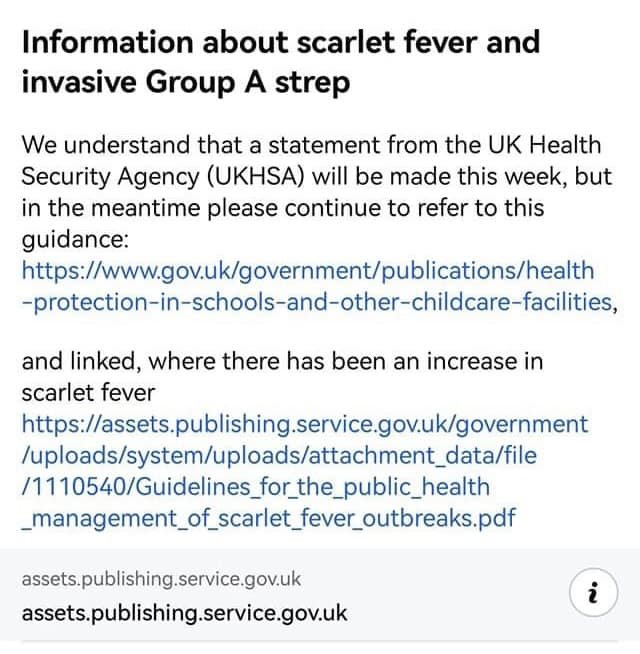Scarlet Fever / Group A Streptococcus
Dear parents, further to my recent post regarding, common colds, D&V bug, viral rashes, chicken pox, hand foot and mouth etc please do read this below as we have children within early years with scarlet fever:
Fact sheet for schools and parents about Group A Streptococcus (GAS)/Scarlet Fever.
What is Group A Streptococcus?
Group A Streptococcus or Streptococcus pyogenes is a bacterium that can be found in the throat and on the skin. People may carry it and have no symptoms of illness or may develop infection.
How is it spread?
Group A Streptococcus survives in throats and on skin for long enough to allow easy spread between people through sneezing and skin contact. People who are currently carrying the bacteria in the throat or on the skin may have symptoms of illness or they may have no symptoms and feel fine. In both cases, these bacteria can be passed on to others.
What kinds of illnesses are caused by Group A Streptococcus?
Most Group A Streptococcus illnesses are relatively mild, with symptoms including a sore throat ("strep throat"), scarlet fever or a skin infection such as impetigo. However, on rare occasions, these bacteria can cause other severe and sometimes life-threatening diseases.
Although scarlet fever is usually a mild illness, it should be treated with antibiotics to minimise the risk of complications and reduce the spread to others.
The symptoms of scarlet fever include a sore throat, headache, fever, nausea and vomiting. This is followed by a fine red rash which typically first appears on the chest and stomach, rapidly spreading to other parts of the body. On more darkly-pigmented skin, the scarlet rash may be harder to spot, but it will still feel like 'sandpaper'. The face can be flushed red but pale around the mouth.
Children who have had chickenpox or influenza (‘flu) recently are more likely to develop more serious infection during an outbreak of scarlet fever and so parents should remain vigilant for symptoms such as a persistent high fever, cellulitis (skin infection) and arthritis (joint pain and swelling). If you are concerned for any reason please seek medical assistance immediately.
What is invasive Group A Streptococcal (iGAS) disease?
Although rare, invasive Group A Streptococcus disease may occur when bacteria get into parts of the body where bacteria are not usually found. These infections are called invasive Group A Streptococcal disease and can be very serious and even life-threatening.
What are the symptoms of invasive Group A Streptococcal disease?
The most important thing to be aware of are the early signs and symptoms of invasive Group A Streptococcal disease. These are:
• High Fever
• Severe muscle aches
• Localised muscle tenderness
• Redness at the site of a wound
What should I do if my child becomes unwell?
If your child becomes unwell contact your GP practice. Alternatively, you can call NHS111 and you should also call NHS111 if your surgery is closed.
If my child is unwell, should they stay off school?
If your child becomes unwell with these symptoms you should contact your GP practice or call NHS111 (which operates a 24/7 service) to seek advice. If your child is unwell they should stay off school until they are better.
What else can I do to prevent my child from becoming unwell?
Because Group A Streptococcal disease is spread through coughing, sneezing and skin contact, its’s important to have good hand hygiene and catch coughs and sneezes in tissues and throw these away.
If your child is unwell, if child needs calpol please do not attend cygnets for 24 to 48 hours. We will be sending poorly children home for 48 hours not as we do not want to take any unnecessary risks x
This will all help limit the spread of other infections, which are common this time of year.


